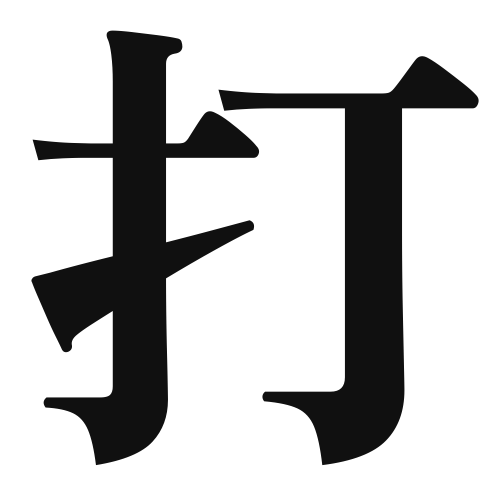1. Overview of Meaning
The kanji “打” (pronounced “da” or “u”) primarily means “to hit” or “to strike.” It is often used in various contexts, including physical actions, sports, and even metaphorical expressions.
2. Origin and Radical
Origin of the Kanji: The kanji “打” is classified as a phono-semantic compound (形声文字), which means it combines a phonetic component with a semantic component. The left part “扌” (a variant of the radical “手” meaning “hand”) indicates an action related to hands, while the right part “打” provides the sound.
Radical: The radical of “打” is “手” (hand), which is commonly associated with actions performed by hands.
3. Examples of Usage
Common Words and Phrases: Some frequently used words that include “打” are:
- 打つ (うつ, “utsu”) – to hit
- 打撃 (だげき, “dageki”) – a blow or strike
- 打楽器 (だがっき, “dagakki”) – percussion instrument
Example Sentences in Daily Conversation:
- 彼はボールを打った。 (かれはぼーるをうった。) – He hit the ball.
- 打撃を受けたチームは負けた。 (だげきをうけたちーむはまけた。) – The team that received a blow lost.
4. Synonyms and Antonyms
Similar Kanji: A similar kanji is “撃” (げき, “geki”), which also means “to strike” but is often used in contexts related to attacks or combat.
Opposite Kanji: An antonym is “守” (まもる, “mamoru”), which means “to protect” or “to guard,” representing an action contrary to hitting or striking.
5. Cultural and Historical Background
Relation to Japanese Culture: The kanji “打” is often associated with traditional Japanese arts, such as martial arts and music, where striking is a fundamental action.
Proverbs and Idioms: One common idiom is “打たれ強い” (うたれづよい, “utareduzuyoi”), which means “resilient” or “able to withstand blows,” reflecting the cultural value of perseverance in the face of adversity.
